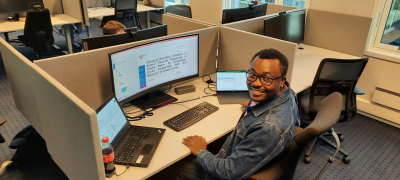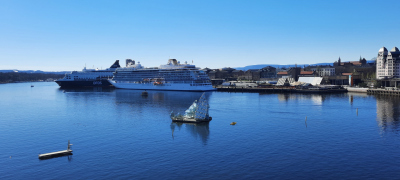- Graduate School GLOMAR
- PhD student reports
- Research Placements
- Opeyemi Ogunleye
Opeyemi Ogunleye
Report of GLOMAR PhD student Opeyemi Ogunleye about his research placement at the Norwegian Technical Institute (NGI) in the section Geohazards and Dynamics from 15 April to 12 June 2023
When I commenced my research placement at Norwegian Geotechnical Institute (NGI) in Oslo, the remaining tasks in my PhD project were to:
- establish statistical boundary condition of subsoil physical properties in Arkona basin (southern Baltic Sea);
- correlate the boundary condition with cone penetration test (CPT) data; and
- demonstrate post-stack acoustic impedance of subsoil units as a reliable indicator of lithologic and geotechnical properties in my study area.
At NGI, I mainly worked in Geohazards and Dynamics section headed by Dr. Maarten Vanneste, a geoscientist. I equally worked very closely with other geoscientists, particularly Dr. Guillaume Sauvin and Dr. Jean-Remi Dujardin, who were well-versed in application of geophysics to offshore wind farm construction. Since my work required a multidisciplinary approach, I also gained from hands-on experience of geotechnical engineers and statisticians involved in offshore projects for NGI.

My research placement commenced with Dr. Sauvin introducing me to staff members that I would come across during my stay. In the first week, I made a presentation of my research work before NGI staff members for them to know what I have done prior to my visit and my objectives for the research stay. During the course of the presentation, it was clear that since I was working in a glacially influenced terrain where chalk served as pre-Quaternary bedrock, it was imperative for me to learn not only from geotechnical engineers who have worked with similar lithology and geological environment, but also from statisticians. The specific engineers and statistician suggested by Dr. Vanneste were Vaughan Meyer, Pauline Suzuki and Nezam Bozorgzadeh of NGI. The geotechnical engineers reviewed my CPT interpretation procedure and products, and provided articles about typical values of geotechnical parameters for chalk and glacial till. Consequently, I reliably correlated interpretation of soil behavior type with descriptions of seismic facies in my study area. Nezam expounded on a statistical method for calculating prediction interval of physical properties. Furthermore, Drs. Sauvin and Dujardin explained a workflow for inverting post-stack seismic reflection data to generate acoustic impedance, and a machine learning approach for predicting CPT data from acoustic impedance. Based on my work, I was able to come up with seismic attributes (for example, trace envelope and instantaneous frequency) that could serve as guides for CPT prediction. This was also a contribution to NGI’s work. By integrating newly acquired knowledge with what I already knew and did, I have reliably established typical values of acoustic impedance and small strain physical properties (including their uncertainty estimates). These values constitute a boundary condition for initial models of seismic inversion in Arkona basin, and would be an integral part of my second manuscript.
Moreover, Dr. Sauvin inverted a total of 5 seismic reflection profiles for acoustic impedance in my project using a genetic algorithm available at NGI. The products included absolute impedance and relative impedance that were additionally regularised. On each of these profiles, predicted acoustic impedance traces along CPT trajectory were extracted in time domain and depth-converted by Dr. Dujardin using trace numbers and time-depth pairs I provided and a Python script he wrote. Before leaving NGI I interpreted the predicted absolute impedance, relating it with lithologic variations and changes in geotechnical properties. All of these would go into the third manuscript of my PhD project.

I was fascinated by Oslo’s beautiful landscape sculptured by fjord, and surrounding view from high places such as the top of Opera House. I visited Munch museum and Akershus Fortress. Maarten, Guillaume, Jean-Remi and I, along with other NGI workers, went for lunch, dinner and drinks on multiple occasions. Besides, I relished sumptuous meals made from octopus and whale; thanks to Maarten and his family for this.
As seen from above, my research placement was very productive and successful. I achieved my set objectives. In addition to expanding my repertoire of knowledge, my visit to NGI has helped to establish contact with experts for potential scientific collaborations regarding future publication(s). It has equally given me a sense of direction for job-related endeavours post-PhD. Thanks to Dr. Vanneste for his smooth handling of official protocol related to my research visit, and also his major contributions to my knowledge during scientific discussions. Many thanks to NGI staff members that have contributed to my skill acquisition. I unequivocally appreciate my thesis committee members for their foresight and worthwhile suggestion for a research placement. Moreover, I am thankful to GLOMAR for funds it provided for my research visit in Oslo, and Federal Ministry of Economic Affairs and Energy (Germany) for sponsoring my PhD project (SynCore).


